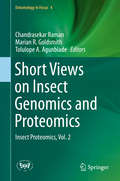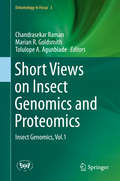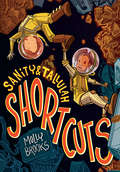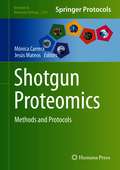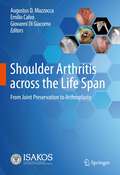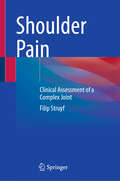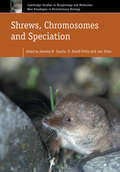- Table View
- List View
Shoot for the Moon: The Space Race and the Extraordinary Voyage of Apollo 11
by James Donovan"This is the best book on Apollo that I have read. Extensively researched and meticulously accurate, it successfully traces not only the technical highlights of the program but also the contributions of the extraordinary people who made it possible." -Mike Collins, command module pilot, Apollo 11When the alarm went off forty thousand feet above the moon's surface, both astronauts looked down at the computer to see 1202 flashing on the readout. Neither of them knew what it meant, and time was running out...ON JULY 20, 1969, Neil Armstrong and Buzz Aldrin became the first humans to walk on the moon. One of the world's greatest technological achievements-and a triumph of American spirit and ingenuity-the Apollo 11 mission was a mammoth undertaking involving more than 410,000 men and women dedicated to winning the space race against the Soviets. Set amid the tensions of the Cold War and the upheavals of the sixties, and filled with first-person, behind-the-scenes details, Shoot for theMoon is a gripping account of the dangers, the challenges, and the sheer determination that defined not only Apollo 11, but also the Mercury and Gemini missions that came before it. From the shock of Sputnik and the heart-stopping final minutes of John Glenn's Mercury flight to the deadly whirligig of Gemini 8, the doomed Apollo 1 mission, and that perilous landing on the Sea of Tranquility-when the entire world held its breath while Armstrong and Aldrin battled computer alarms, low fuel, and other problems- James Donovan tells the whole story. Both sweeping and intimate, Shoot for the Moon is "a powerfully written and irresistible celebration" (Booklist, starred review) of one of humankind's most extraordinary feats of exploration.
Shoot the Moon: Shoot the Moon
by Nicolas Dupont-BlochThe Moon boasts an unexpected variety of landscapes - including volcanic features, sinuous valleys and ghost craters - which are readily visible from Earth. This practical guide explains and demonstrates how you can capture impressive images of our nearest neighbour in space using a variety of different techniques. As the first guide to be dedicated to modern lunar imaging, this volume offers an in-depth and illustrated approach to common optics, the essentials of digital images, imaging devices, and image processing software. Even in light-polluted areas, the countless features and finest details of the Moon can be captured by following the instructions in this comprehensive and accessible guide. Covering equipment ranging from smartphones and DSLRs to specialist planetary cameras, whether you are a novice without a telescope, an amateur developing your skills in imaging, or an experienced astrophotographer, you will benefit from the hints, insights and expertise within.
Shooter's Bible Guide to Handloading: A Comprehensive Reference for Responsible and Reliable Reloading
by Wayne Van ZwollA thorough resource on handloading at home, Shooter’s Bible Guide to Handloading provides detailed information about the history of handloading and key figures’ innovations, a simple explanation of hand reloading, selecting the basic tools needed, and choosing your cases, dies, primers, and powders as well as step-by-step instructions for reloading firearm cartridges and how to test your loads at the range. The text is supplemented by more than one hundred detailed photographs that illustrate the various types of reloading equipment available and provide guidance in performing the actions that result in a handloaded cartridge. The Shooter’s Bible Guide to Handloading covers interesting engineering questions the handloader may consider, including bullet integrity, copper bullets, and energy versus killing power. Other topics covered include: Handloading the old-fashioned way Casting your own bullets The influence of barrel length Economics of home reloading And much more! Pick up a copy of the Shooter’s Bible Guide to Handloading to learn everything you need to know about reloading by hand at home.
Shopping Our Way to Safety: How We Changed from Protecting the Environment to Protecting Ourselves
by Andrew Szasz&“Not long ago, people did not worry about the food they ate. They did not worry about the water they drank or the air they breathed. It never occurred to them that eating, drinking water, satisfying basic, mundane bodily needs might be a dangerous thing to do. Parents thought it was good for their kids to go outside, get some sun. &“That&’s all changed now.&” —from the Introduction Many Americans today rightly fear that they are constantly exposed to dangerous toxins in their immediate environment: tap water is contaminated with chemicals; foods contain pesticide residues, hormones, and antibiotics; even the air we breathe, outside and indoors, carries invisible poisons. Yet we have responded not by pushing for governmental regulation, but instead by shopping. What accounts for this swift and dramatic response? And what are its unintended consequences? Andrew Szasz examines this phenomenon in Shopping Our Way to Safety. Within a couple of decades, he reveals, bottled water and water filters, organic food, &“green&” household cleaners and personal hygiene products, and &“natural&” bedding and clothing have gone from being marginal, niche commodities to becoming mass consumer items. Szasz sees these fatalistic, individual responses to collective environmental threats as an inverted form of quarantine, aiming to shut the healthy individual in and the threatening world out. Sharply critiquing these products&’ effectiveness as well as the unforeseen political consequences of relying on them to keep us safe from harm, Szasz argues that when consumers believe that they are indeed buying a defense from environmental hazards, they feel less urgency to actually do something to fix them. To achieve real protection, real security, he concludes, we must give up the illusion of individual solutions and together seek substantive reform. Andrew Szasz is professor and chair of the department of sociology at the University of California at Santa Cruz and author of the award-winning EcoPopulism (Minnesota, 1994).
Shorebird Ecology, Conservation, and Management
by Mark A. ColwellShorebirds are model organisms for illustrating the principles of ecology and excellent subjects for research. Their mating systems are as diverse as any avian group, their migrations push the limits of endurance, and their foraging is easily studied in the open habitats of estuaries and freshwater wetlands. This comprehensive text explores the ecology, conservation, and management of these fascinating birds. Beginning chapters examine phylogenetic relationships between shorebirds and other birds, and cover shorebird morphology, anatomy, and physiology. A section on breeding biology looks in detail at their reproductive biology. Because shorebirds spend much of their time away from breeding areas, a substantial section on non-breeding biology covers migration, foraging ecology, and social behavior. The text also covers shorebird demography, population size, and management issues related to habitat, predators, and human disturbances. Throughout, it emphasizes applying scientific knowledge to the conservation of shorebird populations, many of which are unfortunately in decline.
Shores of Knowledge: New World Discoveries and the Scientific Imagination
by Joyce Appleby"Uncommonly good . . . makes a compelling case that . . . intellectual curiosity not only changed Europe, but launched modernity." --Cleveland Plain Dealer When Columbus first returned to Spain from the Caribbean, he dazzled King Ferdinand and Queen Isabella with exotic parrots, tropical flowers, and bits of gold. Inspired by the promise of riches, countless seafarers poured out of the Iberian Peninsula and wider Europe in search of spices, treasure, and land. Many returned with strange tales of the New World. Curiosity began to percolate through Europe as the New World's people, animals, and plants ruptured prior assumptions about the biblical description of creation. The Church, long fearful of challenges to its authority, could no longer suppress the mantra "Dare to know!" Noblemen began collecting cabinets of curiosities; soon others went from collecting to examining natural objects with fresh eyes. Observation led to experiments; competing conclusions triggered debates. The foundations for the natural sciences were laid as questions became more multifaceted and answers became more complex. Carl Linneaus developed a classification system and sent students around the globe looking for specimens. Museums, botanical gardens, and philosophical societies turned their attention to nature. National governments undertook explorations of the Pacific. Eminent historian Joyce Appleby vividly recounts the explorers' triumphs and mishaps, including Magellan's violent death in the Philippines; the miserable trek of the "new Argonauts" across the Andes on their mission to determine the true shape of the earth; and how two brilliant scientists, Alexander Humboldt and Charles Darwin, traveled to the Americas for evidence to confirm their hypotheses about the earth and its inhabitants. Drawing on detailed eyewitness accounts, Appleby also tells of the turmoil created in the all societies touched by the explorations. This sweeping, global story imbues the Age of Discovery with fresh meaning, elegantly charting its stimulation of the natural sciences, which ultimately propelled Western Europe toward modernity.
Short Fibre Reinforced Cementitious Composites and Ceramics (Advanced Structured Materials #95)
by Jürgen Schnell Heiko HerrmannThis volume shines a new light on short fibre reinfoced cementitious composites and particle reinforced ceramics. It offers insight from various disciplines like civil engineering, material sciences and micro-mechanics, and collects 9 experimental, numerical and theoretical studies written by top researchers in composite concrete science. The book presents the outcome of the EUROMECH 582 colloquium “Short Fibre Reinfoced Cementitious Composites and Ceramics” held 20 – 22 March 2017, Tallinn, Estonia.
Short Pulse Laser Systems for Biomedical Applications
by Kunal Mitra Stephanie MillerThis book presents practical information on the clinical applications of short pulse laser systems and the techniques for optimizing these applications in a manner that will be relevant to a broad audience, including engineering and medical students as well as researchers, clinicians, and technicians. Short pulse laser systems are useful for both subsurface tissue imaging and laser induced thermal therapy (LITT), which hold great promise in cancer diagnostics and treatment. Such laser systems may be used alone or in combination with optically active nanoparticles specifically administered to the tissues of interest for enhanced contrast in imaging and precise heating during LITT. Mathematical and computational models of short pulse laser-tissue interactions that consider the transient radiative transport equation coupled with a bio-heat equation considering the initial transients of laser heating were developed to analyze the laser-tissue interaction during imaging and therapy. Experiments were first performed to characterize the tissue optical properties needed to optimize the dose for thermal therapy. Experiments were then performed on animal models to characterize the heat affected zone for LITT. The experimental measurements were also validated using the computational models.
Short Views on Insect Genomics and Proteomics
by Chandrasekar Raman Marian R. Goldsmith Tolulope A. AgunbiadeEntomology as a science of inter-depended branches like molecular entomology, insect biotechnology, has made rapid progress. This also implies that there is an urgent need to manage the available resources. In the past five decades, entomology has taken giant steps ahead. The aim of this work is to integrate perspectives across molecular and biochemistry, physiology, reproduction, developmental biology, molecular evolution, genetics and RNAi applications. This century is proclaimed as the Era of Biotechnology and it consists of all types of Mol-Bio-Gen applications, which is an essential component for a thorough understanding of the insect biology. The aim of this work is to provide the comprehensive review of recent research from various geographic areas around the world and contributing authors that are recognized experts in their respective field of Genomic entomology. This Volume emphasizes upon the need for and relevance of studying molecular aspects of entomology in Universities, Agricultural Universities and other centers of molecular research. It will also serve as a landmark source for Insect advance science technology.
Short Views on Insect Genomics and Proteomics
by Chandrasekar Raman Marian R. Goldsmith Tolulope A. AgunbiadeEntomology as a science of inter-depended branches like molecular entomology, insect biotechnology, has made rapid progress. This also implies that there is an urgent need to manage the available resources. In the past five decades, entomology has taken giant steps ahead. The aim of this work is to integrate perspectives across molecular and biochemistry, physiology, reproduction, developmental biology, molecular evolution, genetics and RNAi applications. This century is proclaimed as the Era of Biotechnology and it consists of all types of Mol-Bio-Gen applications, which is an essential component for a thorough understanding of the insect biology. The aim of this work is to provide the comprehensive review of recent research from various geographic areas around the world and contributing authors that are recognized experts in their respective field of Genomic entomology. This Volume emphasizes upon the need for and relevance of studying molecular aspects of entomology in Universities, Agricultural Universities and other centers of molecular research. It will also serve as a landmark source for Insect advance science technology.
Short and Long Distance Signaling
by Friedrich Kragler Martin HülskampThe ability of plants to exchange RNA molecules and transcription factors between cells and tissues is a relatively recent discovery. However, all areas of research such as plant development, metabolism, and plant pathogen interactions now realize the importance of this phenomenon. In this book, experts from the field of intercellular transport deal with various aspects on intercellular transport of viruses and plant endogenous macromolecules such as transcription factors, small silencing-induced and micro RNAs, and other RNAs and their function as signals. The aim of the book is to provide the basic information on the cell-to-cell transport mechanism and to give an overview of the current knowledge of this relatively new field of research. To quote the words of W.J. Lucas "...pioneering discoveries in this field of cell-to-cell and long-distance signaling should certainly entice talented young scholars to join this frontier area of plant biology" . He is certainly right as we got only a first glimpse on the cellular factors regulating intercellular transport and the functional diversity of the ever-increasing number of proteins and RNA molecules found to move between cells.
Short: Walking Tall When You're Not Tall At All
by John SchwartzA SURVIVAL GUIDE TO GROWING UP SHORT. Part science book, part memoir—abook for everyone concerned about looking (or feeling) different.When veteran journalist John Schwartz took a close look at famous height studies, he made a surprising discovery: being short doesn't have to be a disadvantage! Part advice book, part memoir, and part science primer, this fascinating book explores the marketing, psychology, and mythology behind our obsession with height and delivers a reassuring message to kids of all types that they canwalk tall—whatever it is that makes them different.Short is a 2011 Bank Street - Best Children's Book of the Year.
Shortcuts (Sanity & Tallulah #3)
by Molly BrooksEverything is up in the air when the problem-solving best friends Sanity and Tallulah find themselves co-pilots on an unplanned adventure filled with action, adventure, and dangerous situations.Tallulah is great at piloting! And with her learner's permit freshly reinstated, she has the perfect opportunity to prove it: filling in on the mail route to nearby stations while all the regular pilots are out sick. It's her first big solo flight, and yeah, okay, her parking could use some work, but she's not even a little bit nervous—she's got Sanity along as copilot, plenty of old flight logs for navigation, and they'll be in radio contact with Wilnick almost the whole time. All they have to do is follow the pre-approved route and stay out of the dangerous, uncharted, explosives-littered debris cloud . . . no matter how tempting a shortcut it is. Oh, and don't cross the military blockade into the United Territories, obviously. See? No sweat!Sanity and Tallulah's pre-approved route didn't say anything about space stations exploding, enemies in need of rescue, or getting caught in the middle of a border crisis in danger of escalating into all-out war, but sometimes totally awesome pilots have to change plans on the fly, and only an excellent copilot can keep things from going completely upside down.
Shot-Earth for an Eco-friendly and Human-Comfortable Construction Industry (Springer Tracts in Civil Engineering)
by Angelo Marcello Tarantino Marco Viviani Franco CotanaThis book presents an innovative and environmentally friendly type of excavated earth-based building material, called Shot-Earth. The use of a common excavated earth as a construction material (both for structural and non-structural applications) has many important advantages, the main one being that the soil can be used as a zero kilo and zero cost material, being used in the same place where it is excavated. This volume collects the main results obtained by the research units in the FIRS2019-00245 research project, funded by the Italian Ministry of Research (MUR) and dedicated to the study of Shot-Earth materials. Many of the exposed contributions concern the optimization of the mixture and application technique, which consists in the application of the mixture sprayed on a support (that serves as formwork), with or without reinforcements, by using a pressure pipe (that is by a high-speed projection). This new construction technique allows to quickly realise a variety of structural systems, even with a complex geometry (like vaults, arches, shells, tunnel coatings, underground tanks, waterproofing of walls for landfills and waste storages, slope stabilization, etc.). An additional feature of Shot-Earth is that it can be used to realise high energy-efficient buildings. In particular, this innovative technology can improve the capacity of a building to auto-regulate its interior heat and humidity, increasing indoor environment quality and energy performance and reducing building gas emissions.
Shotgun Proteomics
by Daniel Martins-de-SouzaShotgun Proteomics: Methods and Protocols serves as a vital collection of protocols through which thousands of proteins can be simultaneously identified, quantified and characterized in a high throughput manner. Beginning with the history of proteomics centered on the vital role of mass spectrometry in its development, this detailed volume continues with chapters on sample pre-fractionation, in vivo and in vitro stable isotope labeling, label-free proteomics, informatics, protein-protein interactions, targeted proteomics and post-translational modifications. Written for the highly successful Methods in Molecular Biology series, chapters include introductions to their respective topics, lists of the necessary materials and reagents, step-by-step, readily reproducible laboratory protocols and tips on troubleshooting and avoiding known pitfalls. Practical and comprehensive, Shotgun Proteomics: Methods and Protocols is an ideal and up-to-date guide for researchers seeking to understand the proteome of any given species.
Shotgun Proteomics: Methods and Protocols (Methods in Molecular Biology #2259)
by Mónica Carrera Jesús MateosThis edition details a collection of specific shotgun proteomics-based laboratory techniques and applications developed in leading laboratories and proteomics units worldwide. Chapters cover a broad range of topics covering, shotgun proteomics of extracellular vesicles and subcellular structures, shotgun proteomics in non-model organisms, clinical proteomics, food proteomics, analysis of post-translational modifications and protein complexes, and data processing and storage. Written in the highly successful Methods in Molecular Biology series format, chapters include introductions to their respective topics, lists of the necessary materials and reagents, step-by-step, readily reproducible laboratory protocols, and tips on troubleshooting and avoiding known pitfalls. Authoritative and cutting-edge, Shotgun Proteomics: Methods and Protocols aims to be an up-to-date guide for researchers seeking to understand the proteome of any given biological sample.
Shoulder Arthritis across the Life Span: From Joint Preservation to Arthroplasty
by Augustus D. Mazzocca Emilio Calvo Giovanni Di GiacomoThis book comprehensively covers the diagnosis, classification, assessment, and management of shoulder arthritis, a condition with increasing incidence that affects people of all ages. In a multidisciplinary format, it discusses imaging, laboratory testing, nutrition, surgery and rehabilitation.The first part of the book covers conservative treatments, followed by various minimally invasive treatments and specific techniques in the second part. The subsequent parts of the book focus on joint replacement, including alternative options to traditional arthroplasty. Each part is further divided by age group, addressing specific considerations unique to each population. The final part explores new technologies applied to shoulder arthroplasty. Published in collaboration with ISAKOS, this book provides a thorough discussion on how to prevent failure, diagnose, and manage shoulder arthritis in patients of all ages. Written by leading international shoulder experts, it is an essential resource for shoulder surgeons, rehabilitators, and other healthcare practitioners.
Shoulder Pain: Clinical Assessment of a Complex Joint
by Filip StruyfIn this book, Professor Filip Struyf explores the epidemiology of shoulder pain and provides a concise explanation of shoulder anatomy, helping healthcare providers understand how this complex joint functions. He discusses various approaches to problem-solving in shoulder pain and offers an overview of questionnaires, patient-reported outcome measures (PROMs), and patient-reported experience measures (PREMs) used to assess pain, function, and the psychosocial experience of patients. The book also addresses important topics such as screening for red flags and the initial contact with the patient. It provides insights into effective communication strategies and teaches how to build a good relationship with individuals suffering from shoulder pain. Readers will immerse themselves in the clinical assessment of patients with shoulder complaints, including visual inspection, palpation, and comprehensive movement examinations. The book covers various typical shoulder conditions, such as rotator cuff-related shoulder pain, biceps tendon and labral disorders, rotator cuff tears, frozen shoulder, glenohumeral instability, neurological shoulder pain, and much more. Additionally, it offers insights into the role of imaging in diagnosing various shoulder conditions. In summary, this is an essential reference for healthcare professionals interested in shoulder pain.
Show Me the Bone: Reconstructing Prehistoric Monsters in Nineteenth-Century Britain and America
by Gowan DawsonNineteenth-century paleontologists boasted that, shown a single bone, they could identify or even reconstruct the extinct creature it came from with infallible certainty--"Show me the bone, and I will describe the animal!" Paleontologists such as Georges Cuvier and Richard Owen were heralded as scientific virtuosos, sometimes even veritable wizards, capable of resurrecting the denizens of an ancient past from a mere glance at a fragmentary bone. Such extraordinary feats of predictive reasoning relied on the law of correlation, which proposed that each element of an animal corresponds mutually with each of the others, so that a carnivorous tooth must be accompanied by a certain kind of jawbone, neck, stomach, limbs, and feet. Show Me the Bone tells the story of the rise and fall of this famous claim, tracing its fortunes from Europe to America and showing how it persisted in popular science and literature and shaped the practices of paleontologists long after the method on which it was based had been refuted. In so doing, Gowan Dawson reveals how decisively the practices of the scientific elite were--and still are--shaped by their interactions with the general public.
Show and Tell! Great Graphs and Smart Charts: An Introduction to Infographics
by Stuart J. MurphyA visual-learning expert races up the charts and graphs math success with kid-friendly content sure to help with homework.Want to find the most popular meal in the cafeteria? Compare town sports enrollments? Or maybe you just want to know who burps the most in your family! Learn what line graphs, bar graphs, pie charts, and pictographs are and how and when to use them to represent data. Each project shows how to build a chart or graph and ties it all together with a creative infographic that really puts the A in STEAM (Science, Technology, Engineering, ARTS, and Mathematics). Whether used as an introductory aid or to underscore previous knowledge, the book prepares today's visually savvy children to succeed in school and life by analyzing the world around them.
Showing Time: In Memory of Alberto Argenton
by Ian F. Verstegen Laura Messina-Argenton Tiziano Agostini Tamara PrestHow does a visual artist manage to narrate a story, which has a sequential and therefore temporal progression, using a static medium consisting solely of spatial sign elements and, what is more, in a single image? This is the question on which this work is based, posed by its designer, Alberto Argenton, to whose memory it is dedicated. The first explanation usually given by scholars in the field is that the artist solves the problem by depicting the same character in a number of scenes, thus giving indirect evidence of events taking place at different times. This book shows that artists, in addition to the repetition of characters, devise other spatial perceptual-representational strategies for organising the episodes that constitute a story and, therefore, showing time. Resorting to the psychology of art of a Gestalt matrix, the book offers ha formattato: Italiano (Italia) Codice campo modificato ha formattato: Italiano (Italia) ha formattato: Italiano (Italia) researchers, graduates, advanced undergraduates, and professionals a description of a large continuous pictorial narrative repertoire (1000 works) and an in-depth analysis of the perceptual-representational strategies employed by artists from the 6th to the 17th century in a group of 100 works narrating the story of Adam and Eve.
Showstopper!: The Breakneck Race to Create Windows NT and the Next Generation at Microsoft
by G. Pascal ZacharyThis &“inside account captures the energy—and the madness—of the software giant&’s race to develop a critical new program. . . . Gripping&” (Fortune Magazine).Showstopper is the dramatic, inside story of the creation of Windows NT, told by Wall Street Journal reporter G. Pascal Zachary. Driven by the legendary David Cutler, a picked band of software engineers sacrifices almost everything in their lives to build a new, stable, operating system aimed at giving Microsoft a platform for growth through the next decade of development in the computing business. Comparable in many ways to the Pulitzer Prize–winning book The Soul of a New Machine by Tracy Kidder, Showstopper gets deep inside the process of software development, the lives and motivations of coders and the pressure to succeed coupled with the drive for originality and perfection that can pull a diverse team together to create a program consisting of many hundreds of thousands of lines of code.
Shrews, Chromosomes and Speciation (Cambridge Studies in Morphology and Molecules: New Paradigms in Evolutionary Bio #6)
by Jeremy B. Searle P. David Polly Jan ZimaThe chromosome complement (karyotype) often differs between related mammalian species (including humans vs chimpanzees), such that evolutionary biologists muse whether chromosomal difference is a cause or a consequence of speciation. The common shrew is an excellent model to investigate this problem because of its many geographical races (potential species) differing chromosomally, and its several sibling species (recently speciated forms) that are also chromosomally different. This system is an exceptional opportunity to investigate the role of chromosomes in speciation and this volume reflects detailed research following these approaches. Highlights include the demonstration that chromosomal re-arrangements can be associated with complete loss of gene flow and thus speciation and that selection within species hybrid zones may lead to de-speciation rather than speciation. This book represents an extraordinarily detailed consideration of the role of chromosomes in speciation in one astonishing species, providing insights to those interested in mammalian diversity, chromosomal evolution and speciation.
Shrewsbury in the Great War: Shrewsbury In The Great War (Your Towns & Cities in the Great War)
by Dorothy NicolleWars are not just about the people who fight. Those who wait at home suffer too. This book gives an insight into how the people of Shrewsbury lived through those years. Chapters describe the arrival in the town of Belgian refugees and, not long afterwards, of prisoners of war and the reaction of the local people to them all; the enlistment and later conscription of men and the tribunals held to consider the applications of those who wanted to avoid being called up; the establishment of hospitals in local houses for the treatment of the war wounded; and finally the raising of subscriptions for memorials to those who had been killed.Throughout this period most people tried to live as normal a life as possible, despite the absence of so many of their menfolk. They had to cope with food shortages and new laws that restricted so many aspects of their lives. Alongside this they lived with the constant dread of news from the front.
Shrimp Culture Technology: Farming, Health Management and Quality Assurance
by Soottawat Benjakul Avtar Singh Prabjeet Singh Anuj TyagiThis book focuses on the global scenario of shrimp farming, shrimp culture practices, shrimp biology, taxonomy, and major disease challenges along with disease diagnostics in shrimp farming. It covers all the recent advancements in shrimp culture technology and serves as a comprehensive guide for all the stakeholders associated with the shrimp industry, including academicians, students, research laboratories, shrimp culturists, and institutional libraries. This book discusses major disease challenges, disease diagnostics, value addition, quality control, industry scenario, marketing, and processing. The book chapters are elucidated with pictorial representations and self-explanatory flow charts. Individual chapters devoted to shrimp pathology, major disease challenges, pathogen isolation techniques, and diagnostic methods are important parts of the book. This book is of interest to aquaculture practitioners, academicians, students, and researchers directly or indirectly involved in shrimp culture.







